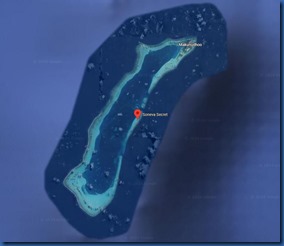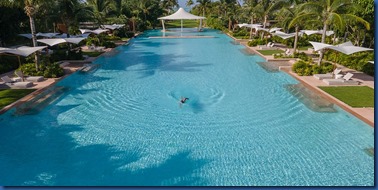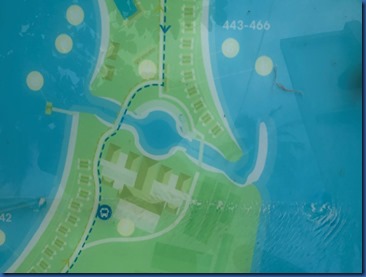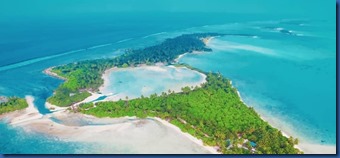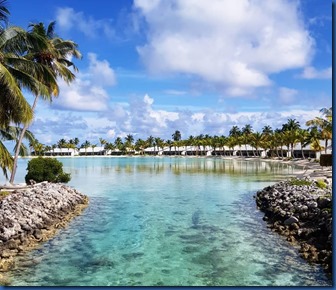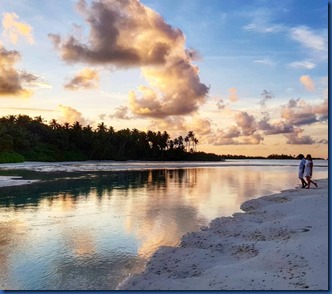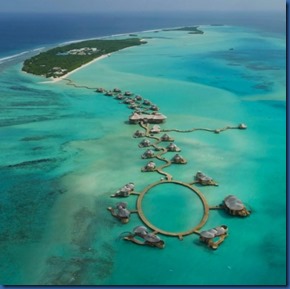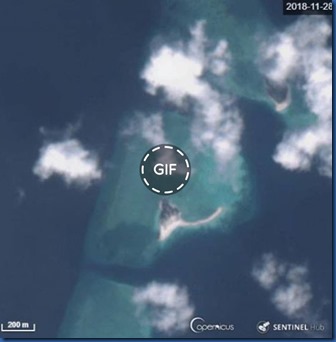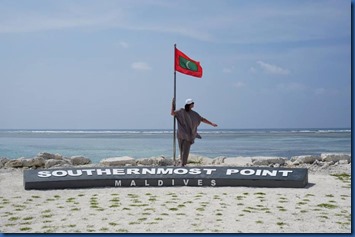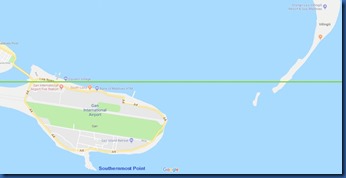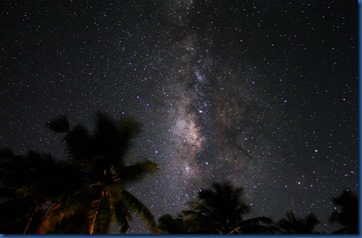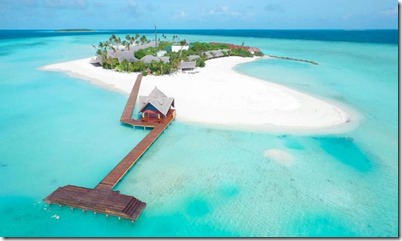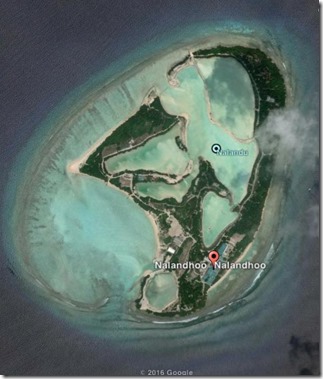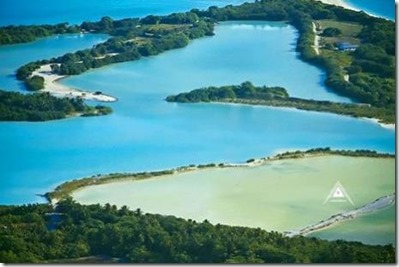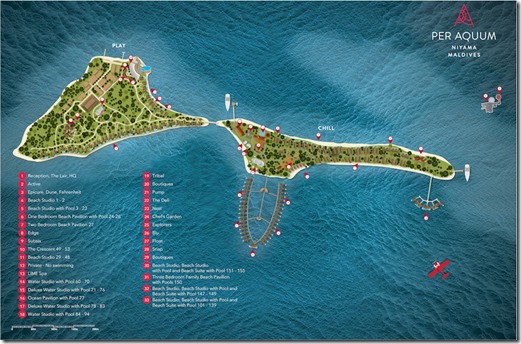Having visited 17 of Maldives atolls, there aren’t many left we haven’t been to, but Soneva Secret recently launched in an atoll – Mkaundhoo – that we have not only never been to, but I hadn’t even heard of! One of the distinctive experiences of the Maldives is the dramatic sense of being away from it all in the middle of the ocean. Soneva has taken that dimension to the next level with their “Secret” refuge.
Best of the Maldives: Swimming “Pool” Channel – Ailafushi
Some people ask why people want pools in the Maldives when there is some much delightful water surrounding the entire property. One advantage is that a pool provides a swimming area more protected from currents. Well, Ailafushi’s island is sculpted with a channel dissecting it with a circular “pool” right in the centre. It not only offers a natural bathing spot for the aquatically minded, but also an alluring water feature for the landlubbers. More and more new islands have been built with terrforming, but this shows that you can craft the water-scape as well.
Best of the Maldives: Salt Water Lake – Rahaa
While most Maldives aficionados seek out the best house reefs (with their plummeting walls of coral), the Maldives lagoons are equally as distinctive. They might not make for the finest snorkelling adventures since they are essentially just shallow pools of water with sandy bottoms. Typically, not much marine life to see except for a few foraging sting rays and the wandering couple of goat fishes. But the lagoons are what give the Maldives its distinctive palette of soft blues and provide ocean swimming that is as calm as a backyard pool.
Rahaa’s “salt water” lake is one of the most distinctive resort bodies of water in the Maldives (thanks Francisco). Other resorts feature “lakes”, but none so front and center. None with villas on the shores and none you can swim in. Now whether Rahaa’s “lake” is really and lake or a totally landlocked lagoon is a bit of a semantic fine point. It is as notable a water feature as you’ll find in a destination that epitomises water features.
Best of the Maldives: Lowest Density – Soneva Jani
While there might be miles of open ocean to gaze out on, the Maldives islands themselves are famously diminutive. For people seeking the get-away-from-it-all (including getting away from everybody), they sometimes wonder whether these tiny islands mean that people are crammed in (which led to me adding the “Population Density” field to the Maldives Complete database).
Soneva Jani now boasts the least inhabited of the resort islands with 10,650 square meters per guest. The Daily Mail reported…
- “In terms of space, Roman told us, Soneva Jani (the Sanskrit word for ‘wisdom’) is one of the lowest-density resorts in the world, with only 25 villas on 150 acres of land.”
Coincidentally, previous low crowd mark was its sister resort, Soneva Fushi (with 10,592)
Shifting Sands
If you try sitting on the sands of the bay in the Maldives for too long, you might just find yourself in the bay itself. This very item was going to be a “Haven’t Seen” until I found it on Facebook just a few days before my post.
- “Only from a time-lapse like this you will see clearly how the Maldivian Islands change shape so fast. Lhaviyani Atoll Veyvah and Vavvaru (26-08-2015 to 28-11-2018)”
Still an opportunity for a resort to provide one. Resorts AaaVee and Mafushivaru’s Lonobu have dramatically shifting sands, for example.
Best of the Maldives: Southernmost Point – Equator Village
Shangri-La Villingili might be the “Southernmost Resort”, but Equator Village gets you to the Southernmost Point, the tippy-toe, of the Maldives on its Gan island (as you can see from the map below, Villingili resort island extended below the position of Equator Village, but the rest of Gan island outside the resort compound goes further south). Maldives Complete roving reporter Paola posted the above photo of this geographic extremity on the very tip of Gan’s southern promontory.
Compass point extremes have a strange allure. Like you have gone to the very edge of the place in question. The planet carries on pretty much like the surrounding area, but still you feel like you have reach to the limit of this destination. Especially in the Maldives which stretches so extensively from north to south for nearly a thousand kilometres. Our son, Chase (himself a veteran of many Maldives trips) has explored these topological margins with his field recording both in the USA (Key West where we stayed at the Southernmost Hotel) and the UK (where he undertook a project to record all for compass points extremes in Britain which ended up in the British Library).
Best of the Maldives: Darkest Skies – Filitheyo
While the Black Moon might be the darkest month to the do some stargazing, where is the darkest place in the Maldives. Lots of factors affect visibility – light pollution from the moon, cloud/haze cover – but one of the biggest is light pollution from the ground. This light is what makes star gazing so difficult in built up areas and why the best observatories are located in the remote locations far from ambient light sources.
The question came up on the TripAdvisor Maldives Forum as few months ago. I pulled NASA’s night time photos of the world. As expected, there are not many lights in the Indian Ocean. The high-res TIFF shows basically 3 tacked vertically north to south. The northern most (and by far the brightest) is Male, the middle is Gan and the southernmost is the British Indian Island Territory.
I was going to examine which parts of the Maldives were the furthest from Male (without getting close to Gan). I’ve overlaid Google Maps onto the NASA photo to provide some perspective –
But doing a bit of research on skyglow shows that it doesn’t really extend beyond a few dozen miles from the major light. Check out the UK map on this site.
There is also the question of “glare” which is the light from the immediate vicinity. This light does add to the sky glow, but more importantly it adds “glare” to your viewing. So in short, you are looking for a resort who has relatively secluded villas (ie. away from the dense infrastructure of the resort operations and main public areas) and ideally one where the lighting is used sparsely.
A simpler resort like Rihiveli comes to mind (less infrastructure). A resort without water villas (at least on your side of the island) will eliminate the inevitable jetty and water villa lights (they don’t want people stumbling into the water).
This methodology narrowed down the possibilities to a couple of possibilities in some more remote, less populated atolls…
- Filitheyo, Faafu (distance to capital island – 20 km)
- Alimatha/Dhiggiri, Felidhoo (distance to capital island – 12 km, lowest population atoll)
I decided to lean to Filitheyo because Alimatha and Dhiggiri, though smaller and simpler resorts, are both near each other throwing skyglow on each other, while Filitheyo is all by itself 20 km (about the right distance for avoiding skyglow) from the major island in the atoll.
Best of the Maldives: Beachiest – Dhigufaru
The first thing that hits you about Dhigufaru is the beach. It leaps out of the promotional pictures when you are researching and planning your visit (see above). And its vast expanse of dazzling white hits you again as soon as you step off the seaplane.
Many resorts make bold claims about being the biggest or the best. Often these aspects are quite subjective. I might consider a “Best of the Maldives” piece if they have something substantive to hang their claims on, but sometimes I can get some real numbers for comparison sake especially for Geography superlatives (eg. Biggest Island, Lowest Population Density). So I took out my trusty calculator (spreadsheet) actually to estimate what portion of the Dhigufaru island was actually beach. The resort wasn’t making any claims about it, but I was.
By my calculations, the island is 42% beach by square metre which is the top of any active resort I can find (the runners up were Rihiveli, Gili Lankanfushi, Cocoa Island). If you are looking for that plot-of-sand-with-a-palm-tree aesthetic (pile of sand, a little vegetation, and all set in a vast ocean), then Dhigufaru is it.
Best of the Maldives: Curious Shape – Nalandhoo
Earth Day today. A time to appreciate the diverse and curious planet we call home. In the Maldives, Not all the earthen mounds of islands are round dots. Some extend across elongated table reefs on the edges of the atolls. And some like Nalandhoo (not to be confused with Anatara’s Naladu) in Shaviyani atoll have a totally unique shape viewed from Google Earth(thanks Paola)…
Nalandhoo is particularly supportive to Earth Day today as its own emblematic exposure to environmental impacts especially of rising and shifting seas…
- “The smallness of the [Shaviyani] atoll indicates to the islands’ vulnerability to environmental impacts. Hence the Nalandhoo is one of the island in Shaviyani atoll with its own unique beauty”

